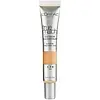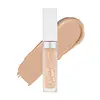L'Oreal True Match Eye Cream in a Concealer 0.5% Hyaluronic Acid Versus Colourpop No Filter Concealer
What's inside
What's inside
 Key Ingredients
Key Ingredients

 Benefits
Benefits

 Concerns
Concerns

 Ingredients Side-by-side
Ingredients Side-by-side

Water
Skin ConditioningGlycerin
HumectantCaprylyl Methicone
Skin ConditioningPropanediol
SolventDimethicone
EmollientPentylene Glycol
Skin ConditioningDimethicone/PEG-10/15 Crosspolymer
Alcohol Denat.
AntimicrobialSodium Hyaluronate
HumectantSodium Chloride
MaskingTriethoxysilylethyl Polydimethylsiloxyethyl Dimethicone
Skin ConditioningIsopropyl Titanium Triisostearate
EmollientPhenoxyethanol
PreservativeAscorbyl Glucoside
AntioxidantCaprylyl Glycol
EmollientTrisodium Ethylenediamine Disuccinate
Alumina
AbrasiveDipropylene Glycol
HumectantSodium Citrate
BufferingTocopherol
AntioxidantCI 77891
Cosmetic ColorantCI 77491
Cosmetic ColorantCI 77492
Cosmetic ColorantCI 77499
Cosmetic ColorantCI 77163
Cosmetic ColorantMica
Cosmetic ColorantWater, Glycerin, Caprylyl Methicone, Propanediol, Dimethicone, Pentylene Glycol, Dimethicone/PEG-10/15 Crosspolymer, Alcohol Denat., Sodium Hyaluronate, Sodium Chloride, Triethoxysilylethyl Polydimethylsiloxyethyl Dimethicone, Isopropyl Titanium Triisostearate, Phenoxyethanol, Ascorbyl Glucoside, Caprylyl Glycol, Trisodium Ethylenediamine Disuccinate, Alumina, Dipropylene Glycol, Sodium Citrate, Tocopherol, CI 77891, CI 77491, CI 77492, CI 77499, CI 77163, Mica
Water
Skin ConditioningCyclopentasiloxane
EmollientDimethicone
EmollientCaprylyl Methicone
Skin ConditioningButylene Glycol
HumectantSilica
AbrasiveCetyl Diglyceryl Tris(Trimethylsiloxy)Silylethyl Dimethicone
Emulsion StabilisingPEG-10
HumectantDimethicone/Vinyl Dimethicone Crosspolymer
Skin ConditioningDimethicone Crosspolymer
Emulsion StabilisingPhenyl Trimethicone
Skin ConditioningAlumina
AbrasiveIsopropyl Titanium Triisostearate
EmollientSodium Chloride
MaskingBis-PEG-15 Dimethicone/Ipdi Copolymer
PEG-2 Soyamine
EmulsifyingPhenoxyethanol
PreservativeCaprylyl Glycol
EmollientTrimethylsiloxysilicate
EmollientTrisodium EDTA
Polypropylsilsesquioxane
Potassium Sorbate
PreservativeHexylene Glycol
EmulsifyingPseudoalteromonas Exopolysaccharides
Skin ConditioningCitric Acid
BufferingSodium Salicylate
PreservativePlankton Extract
Skin ConditioningIron Oxides
CI 77891
Cosmetic ColorantWater, Cyclopentasiloxane, Dimethicone, Caprylyl Methicone, Butylene Glycol, Silica, Cetyl Diglyceryl Tris(Trimethylsiloxy)Silylethyl Dimethicone, PEG-10, Dimethicone/Vinyl Dimethicone Crosspolymer, Dimethicone Crosspolymer, Phenyl Trimethicone, Alumina, Isopropyl Titanium Triisostearate, Sodium Chloride, Bis-PEG-15 Dimethicone/Ipdi Copolymer, PEG-2 Soyamine, Phenoxyethanol, Caprylyl Glycol, Trimethylsiloxysilicate, Trisodium EDTA, Polypropylsilsesquioxane, Potassium Sorbate, Hexylene Glycol, Pseudoalteromonas Exopolysaccharides, Citric Acid, Sodium Salicylate, Plankton Extract, Iron Oxides, CI 77891
Ingredients Explained
These ingredients are found in both products.
Ingredients higher up in an ingredient list are typically present in a larger amount.
Alumina is another name for the compound aluminum oxide. It is used as a thickener, absorbent, and abrasive.
As an absorbent, alumina can give a mattifying effect. It is used in mineral sunscreens to help coat nano-sized filters, such as titanium dioxide. By increasing the size of the UV filters, these ingredients stay on the skin for a longer time. By coating small sized ingredients, alumina helps thicken a product.
Alumina may be used as an abrasive, or exfoliant.
Alumina is naturally occurring in the mineral corundum. Certain varieties of corundum create rubies and sapphires. Corundum is also the crystalline form of alumina.
Learn more about AluminaCaprylyl Glycol is a humectant and emollient, meaning it attracts and preserves moisture.
It is a common ingredient in many products, especially those designed to hydrate skin. The primary benefits are retaining moisture, skin softening, and promoting a healthy skin barrier.
Though Caprylyl Glycol is an alcohol derived from fatty acids, it is not the kind that can dry out skin.
This ingredient is also used as a preservative to extend the life of products. It has slight antimicrobial properties.
Learn more about Caprylyl GlycolCaprylyl Methicone is a type of silicone.
It helps soften and soothe the skin by creating a thin film on top. This film helps trap moisture, keeping your skin hydrated.
Ci 77891 is a white pigment from Titanium dioxide. It is naturally found in minerals such as rutile and ilmenite.
It's main function is to add a white color to cosmetics. It can also be mixed with other colors to create different shades.
Ci 77891 is commonly found in sunscreens due to its ability to block UV rays.
Learn more about CI 77891Dimethicone is a type of synthetic silicone created from natural materials such as quartz.
What it does:
Dimethicone comes in different viscosities:
Depending on the viscosity, dimethicone has different properties.
Ingredients lists don't always show which type is used, so we recommend reaching out to the brand if you have questions about the viscosity.
This ingredient is unlikely to cause irritation because it does not get absorbed into skin. However, people with silicone allergies should be careful about using this ingredient.
Note: Dimethicone may contribute to pilling. This is because it is not oil or water soluble, so pilling may occur when layered with products. When mixed with heavy oils in a formula, the outcome is also quite greasy.
Learn more about DimethiconeIsopropyl Titanium Triisostearate isn't fungal acne safe.
Phenoxyethanol is a preservative that has germicide, antimicrobial, and aromatic properties. Studies show that phenoxyethanol can prevent microbial growth. By itself, it has a scent that is similar to that of a rose.
It's often used in formulations along with Caprylyl Glycol to preserve the shelf life of products.
Chances are, you eat sodium chloride every day. Sodium Chloride is also known as table salt.
This ingredient has many purposes in skincare: thickener, emulsifier, and exfoliator.
You'll most likely find this ingredient in cleansers where it is used to create a gel-like texture. As an emulsifier, it also prevents ingredients from separating.
There is much debate on whether this ingredient is comedogenic. The short answer - comedogenic ratings don't tell the whole story. Learn more about comegodenic ratings here.
The concensus about this ingredient causing acne seems to be divided. Research is needed to understand if this ingredient does cause acne.
Scrubs may use salt as the primary exfoliating ingredient.
Learn more about Sodium ChlorideWater. It's the most common cosmetic ingredient of all. You'll usually see it at the top of ingredient lists, meaning that it makes up the largest part of the product.
So why is it so popular? Water most often acts as a solvent - this means that it helps dissolve other ingredients into the formulation.
You'll also recognize water as that liquid we all need to stay alive. If you see this, drink a glass of water. Stay hydrated!
Learn more about Water